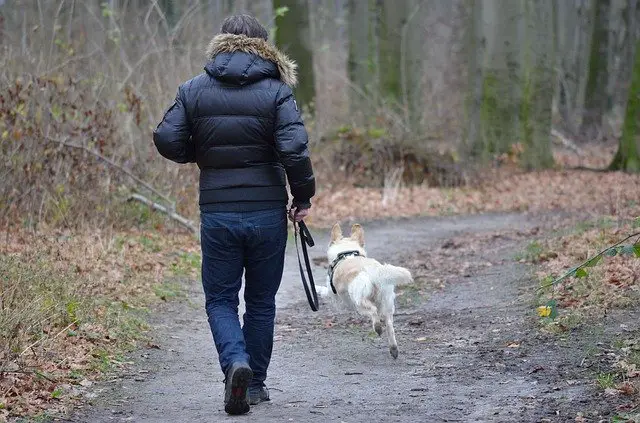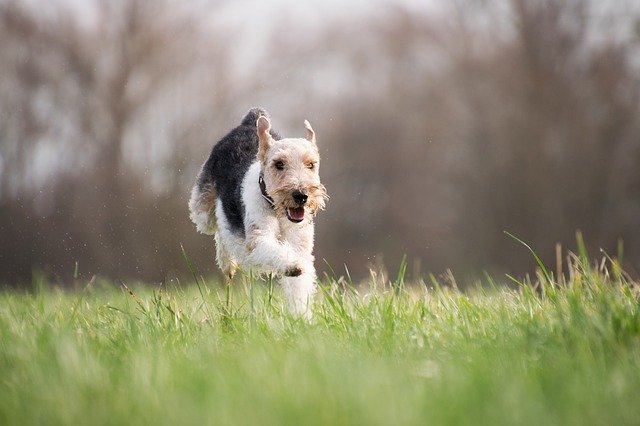
To keep your dog’s bones strong and healthy, walking your dog is very important. But you’re probably wondering just how much exercise does my dog need and how many times a day should I walk my dog? Well, that’s a multi-faceted question with various answers depending on certain factors.
The number of times a day you will walk your dog will depend on the breed of dog you have, their health condition as well as their physical capability. In today’s guide, we cover all the important factors to consider when deciding your dog walking frequency as well as other tips to make it much more productive for both parties.
Table of Contents
Why Should I Walk My Dog Regularly?
1. Weight Control
Exercising your dog regularly helps to burn excess calories and keep your dog at a healthy weight.
2. Improving Joint Health
When you sit for a long time, your legs begin to feel stiff, right? It’s the same with your dog’s joints. Sitting or lying for too long can cause your dog’s legs to feel stiff. Keeping your dogs in motion keeps their joints in great shape and prevent and/or delay the onset of arthritis.
3. Improving Digestive and Urinary Health
You know what happens when your dog takes a walk, he poops, yeah? This is actually important. Walking regularly helps to keep your dog’s pooping regular which is important for the healthy functioning of your dog’s digestive system.
4. Mental Stimulation
To remain alert mentally, your dog needs to go on new adventures regularly. Walking around, seeing new places and things can help your dog remain mentally alert. It also helps to reduce some bad behaviors such as excessive chewing or digging, anxiety, hyperactivity, whining, and excessive barking.
5. Social Structure
Dogs work with a social structure that helps them understand their place and bearing in the world. You’d have to identify yourself as the leader of the pack the dog way so that it makes sense to your dog.
As you walk your dog while holding the leash, you establish your dominance and your dog can walk in relation to you.
6. Socialization
The more your dog interacts with other people and other dogs, the more they learn social cues. They learn to respond better and get more familiar with the environment, in turn, they learn to be better members of the family. They also learn to be more at ease in all kinds of environments.
Check out the video below to see the health benefits of walking your dog for you and your dog. The video also addresses some major challenges with walking your dog as well as how to solve them.
How Often Should I Walk My Dog? — Some Factors To Consider
How often you should work your dog will depend on several factors.
1. Dog Breed

The breed of dog you have will determine how often you should walk your dog in a day. For instance, working or sporting breeds such as Shepherds, Pointers, and Collies, will have higher exercising needs than lapdogs like Papillons, or Yorkshire Terriers.
Also, some dogs are born athletes while others are lazy and mostly just love to laze on the couch. Behaviors such as this can either be affected by the dog’s breed or by the dog’s individual preferences. These behaviors will also determine how much exercise your dog will require.
For instance, a Bassett Hound is most likely to be generally dismissed as a jogging partner. However, there are some Bassett Hounds that have broken this stereotype and gone on to live active lives with their parents.
2. Age
Naturally, puppies and younger dogs are much more active than older dogs. So, these dogs typically require more exercise than their middle-aged and older counterparts. When we say middle-aged, think 5 to 8 years, and 9 years and over for seniors.
As usual, there will be a couple of exceptions to this rule.
However, generally, because of the onset of degenerative diseases such as muscular atrophy and arthritis, as well as other diseases such as diabetes and hyperthyroidism, senior dogs usually have less stamina. So, even when they are rearing to go in their minds, their physical strength isn’t always able to support them.
3. How Much Exercise Can Your Dog Tolerate?
This is another important factor that will affect how often you get to exercise your dog. Some dogs can take a walk for up to 30 minutes daily as long as they are in perfect health. Others can go as long as 2 hours hiking. Different strokes for different folks, right?
With obese dogs, however, you might notice that your dog can only go for a number of minutes before panting heavily and requiring multiple breaks.
That said, you must monitor your dog when you both go on walks. Of course, make sure you go for walks with the right materials, a good harness, leash, and dog lead.
Check out for his energy levels, is he starting off at an energetic pace? When does he begin to slow down into a walk? Is he beginning to pant more, sniff more, explore his surroundings more? Then he might be getting tired.
In that case, it’s time to head on home. Two things can happen in this case. It’s either your dog keeps up his pace or he slows down his pace yet again. If he slows down his pace yet again, then you know that you’ve probably walked too far and you need to shorten your dog walking route.
Your observation doesn’t end there, though. You also want to monitor your dog’s pattern of behavior when you get back home from your walk. Is your dog lapping up water with gusto? Or did he immediately crash on his bed and lay there spent for hours at a time? Then he probably must have overexerted himself.
Also, if you notice your dog limping during or after the walk (even after a long rest), then you’ve probably walked your dog too far.
Exercise tolerance for a dog can increase over time so long as your dog is healthy. But remember to take things slowly. If your dog hasn’t been active for a long time and you’re just introducing him to walking. Understandably, that could take some getting used to. Encourage your dog to walk and let him steadily and gradually push his boundaries and build up tolerance. This way, your dog does not have to endure pain and injury.
4. Your Schedule
Alright, so now you know how much exercise your dog can tolerate. The next question to answer is whether you can create time for this in your busy schedule.
According to the CDC, you should strive to clock in 150 minutes of exercise every week. Now, if you can make out this much time, that would be great. However, we do now that people are very busy these days and making out that much time every week can be a lot.
If you can afford to hire a dog walker to walk your dog, then great. Two to three times a week, a dog worker can come and take your dog for a 10- to 15-minute walk. To supplement this, you can play with your dog in your yard for a few minutes after work if you have a yard.
If you can’t make out time to leash walk your dog, don’t have a yard, or your dog isn’t exactly in tip-top physical conditions, then you could consider trying lower impact activities instead.
Good examples of such lower impact activities include dog puzzle toys. He can roll a Kong Wobbler around the house while walking around the house, albeit at a much slower pace.
In such a case, ensure that your dog engages in these activities, at least, 15 minutes daily. Giving your dog mental and physical outlets to engage himself, your dog will be healthier both mentally, physically, and overall.
5. The Weather
It wouldn’t matter what your dog’s daily walking requirements are if the weather does not agree. It will only be possible to take your dog for walks as often as necessary if the weather agrees.
For instance, you are not supposed to walk your dog during a heatwave as it could damage his paws and even cause overheating which can be fatalistic. During heat waves, walks can only be had twice daily. Before 8 am in the morning and after 8 pm at night. (To get more information, click here to read: When Is It Too Hot To Walk Your Dog?)
Rainy season is also another tricky time to walk your dog. If it’s not especially heavily raining, then you can take your dog on a walk provided he’s properly decked in a sweater and/or a raincoat.
There are dogs that love the rain though. If that’s your dog, then he’ll be eager to go walking in the rain. Other dogs who are not particularly excited about the rain might prefer to be indoors. In that case, you can play some indoor games with your pet until the weather is more conducive.
The video below gives a summary of everything we’ve discussed so far:
Dog Walks Vs Potty Breaks

Your dog gets the potty breaks where he can get a quick romp around the yard. Is a 30-minute walk really all that necessary? Aren’t those quick romps enough? Well, that’s not enough actually. Besides the fact that your dog needs the extra exercise to keep fit, dogs love to explore their surroundings so they love to have longer walks.
Also, longer walks are important to keep your dog mentally stimulated so they don’t become destructive or anxious. The more you spend one-on-one time with your dog, the more you can prevent the onset of attention-seeking behavior such as barking or whining, not forgetting that long walks are a great way for you and your pet to bond.
How Many Times In A Day Should I Walk My Dog? — The Different Walking Needs Of Different Dogs
Generally, for most dogs, 30 minutes to two hours of exercise per day is enough. This translates to about 3.5 to 14 hours of exercise weekly. Since making out that much time at a stretch can be a little challenging, you can break it down into multiple walks per day. It will even be easier for your dog.
But then again, this is just speaking generally. For an answer specific to your dog on how many times in a day you should walk him, that’s going to depend on your dog. There’s no hard and fast rule to it.
Dogs can be categorized into different breed groups, and each of these breed groups has its needs and limitations. Below is a brief overview.
Walking Needs Of Sheepdogs And Cattle Dogs

Sheepdogs such as Border Collies, Sheltie Sheeplands, and Cattle dogs such as Bouvier des Flandres usually require a higher level of activity than most dogs. They need their physical capacities challenged but beyond that, they also need their mental and training capacities stretched as well.
Dogs like this tend to get bored pretty fast with irrelevant games. So, you’d have to get creative with these dogs.
For Sheepdogs and Cattle Dogs, the minimum amount of time they need to spend exercising daily is two hours thirty minutes. That is definitely a lot. If you convert that to walks, you’re looking at about 4 walks daily, lasting between 20 and 25 minutes each.
Now, don’t forget these dogs are also intelligent. So, they’ll also need about 30 minutes for mental exercises as well.
Walking Needs Of Terriers

Terriers are small, trainable, lively dogs with a strong temper. Although they are small, this group of dogs requires a good amount of exercise daily, about one hour thirty minutes of exercise every day.
For such dogs, you might have to take about 3 walks daily, lasting between 20 to 25 minutes per walk. Also throw in some mentally stimulating games as well for about 20 minutes daily to keep them fit both in body and in the mind.
Walking Needs Of Hunting Dogs, Schnauzers, Greyhounds, and Pinschers

Dogs in this group include the Greyhounds, Beagles, Dalmatians, etc. These breeds have about the same exercise requirements as Terriers. They need a minimum of one hour thirty minutes of daily walks and exercise.
Now, these breeds love to run. So, feel free to let them loose. You can even practice their running with them. Just remember to take it step by step and always factor their age in as well.
If you have a dog like this and you’re wondering “how many times in a day should I walk my dog?”, a good idea is to have three thirty-minute walks daily. Don’t forget that these breeds will also require some cognitive activities as well. So, don’t forget to throw that in.
Walking Needs Of Companion Dogs

When we talk about companion dogs or lap dogs, we think of Chihuahuas and the likes. Typically, these dogs are not high-energy dogs so they don’t need long hours of intensive activity. Instead, make your activity times shorter so they keep fit.
In fact, depending on the dog, too much activity can actually affect them negatively. So, take it easy on these breeds. Generally, two short walks daily are enough for dogs of this group.
One Long Walk A Day Or Several Walks A Day?
Dogs that seem to have a lot of energy or behavioral problems are likely in need of longer walks, more walks, or an activity with a higher intensity than walking.
So, say your dog is a high energy dog as you have discovered, and you need to about one and half to two hours of daily walks as you have discovered from what we discussed in the section prior to this one. Would it be better to take one long walk or to break the walk into several short works during the day?
Well, the answer to this question would depend on you and your pet.
As long as there are other outlets for your dog to dispel some energy, it shouldn’t be a big deal whether or not you take one long walk or several walks in one day. Simply do what’s best for you and your schedule.
If your pet is a senior dog, you might want to break up your walks into several short ones in a day so your dog doesn’t get exhausted quickly.
As for puppies, these literally have energy packets by the dozens in their bodies at all times, especially after nap time. If you have a small dog with boundless energy, then it might be best to take a long walk rather than break it up into bits. With a long walk, your dog keeps his heart going through the cardio exercise that the walking provides.
Also, for dogs like Pointers, Huskies, and Hounds that tend to cover a lot of ground, a long stroll resembling a journey might be a more preferable option than taking many short, neighborhood strolls.
How Far Should I Walk My Dog?
How far you and your dog can walk will ultimately depend on your pace (yours and your dog’s). If it’s a casual, slow stroll, with a small dog or a senior dog, then you might not be able to cover much ground. However, if it’s a larger dog and you both are walking briskly, then you’ll definitely be able to cover more ground.
Of course, other factors such as terrain, incline, and weather may affect how long and how far you can walk your dog. Also, keep in mind that if your dog is on a long leash, then it will be easier to cover more ground with your dog.
Generally, dogs are content with a walk of between one to three miles at a time. However, if your dog is a walker, you might find yourselves covering more ground, up to 10 miles or even more.
Now, if you have a puppy, then don’t allow him walk for longer than a few miles at a time until he has fully grown. Instead, let your pup set the pace and focus less on the distance and more on the time she spends walking.
There are dogs that take advantage of long walks by running back and forth or circling. Dogs like this will do well with long walks. If, on the other hand, your dog seems to be stickling close to you or remains behind or ahead of you consistently, then they will cover about the same distance that you cover.
If you want your dog to cover more ground, then you can encourage him by using a flirt pole or throw some toys a short distance ahead of her to keep her reaching for something and walking long distances.
Don’t forget that if your dog is a small breed, he will automatically exert more energy because he trots rather than walking.
Is Walking Your Dog Enough?
Whether a walk (long or several) will be enough to give your dog all the exercise he needs will be totally dependent on your dog and the kind of walk you both have.
If you have a large dog walking on a short lead, then he’ll definitely get less exercise than a small dog bouncing along on a Flexi-lead.
One way to know if your dog has not had a productive, long enough walk is if he’s still over-excited, pulling on the lead, or displaying some behavioral problems after the walk. If he does any of that, then your dog definitely needs more exercise. If he comes back home and takes a nap after your walk, then most likely, he is being exercised enough.
If you think your dog isn’t getting exercised enough from his walks, there are a few things you can do to make your walks a little more intensive for your dog, and they don’t even require too much time or effort.
1. Pulling Weight
Dogs have been doing this for humans for donkey years. In fact, pulling is one of the many challenges dog owners face when it comes to walking their dogs. If your dog loves to pull, you could let him pull so that he gets to exhaust his energy while still getting a job done.
It could be a skateboard or a bike or a weighted sled or cart can introduce a new element to your dog walking that could help your dog exercise more.
With a high-quality harness, your dog will be able to pull comfortably without straining his neck. Padded harnesses are best, obviously, for such exercises.
2. Wearing A Backpack
Many dog owners are not aware of what wearing a backpack can do for their dogs. But letting your dog wear a backpack while you want not only keeps him physically exercised, it also keeps him mentally stimulated. When a dog is wearing a backpack, he enters into work mode which can keep him calm and more focused. In such a case, he’ll be less likely to pull on the leash or act crazy.
To make it even more tasking for your dog, you can put some weights in your backpack. Carrying these weighted backpack as puppies will help your puppy build muscles while also helping to delay the onset of bone degenerative diseases associated with old age in boys.
If you intend to use this method, then choose a high-quality back, preferably lined with mesh so that your dog does not get too hot while on your walk. A handle could also help grab and lift your dog, if you ever have to.
3. Incline Or Shallow Water
If your dog doesn’t seem to be getting exhausted after your walks or he seems bored with your walks, then it might be time to switch to a more challenging terrain. This could help him get more mentally and physically stimulated.
Inclines as well as rough terrains help your dog train his muscles and balance as he picks his way through. Wildernesses and urban jungles make great exploration spots to push your dogs exercising a little further. Getting your dog to balance on a retention wall, a curb, or a low tree branch could help you and your dog get more fun out of your walk.
Another way you can exercise your dog some more on your walks is to have him walk through shallow water. This way, you get to put some strain on your dog’s joints while walking as it takes significantly more effort to wade than to walk. This will, in turn, wear him out quicker. If you live in a hot climate or you have an older dog, this is a fantastic option to go with.
4. Flexi-lead
Flexi-leads have become industry standard. They extend and retract automatically which gives your dog much more freedom while walking and saves you the stress of gathering and letting out your leash every time. These leads come in all sizes from 10 to 26 feet and you can choose any convenient length you want.
Flexi-leas are a better idea for dogs that behave well on a leash naturally, and have a good call back as well. If your dog is still in training or has an unpredictable behavior, it might be better to shorter leashes since it gives you more control until your dog has developed better control.




